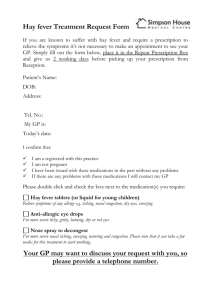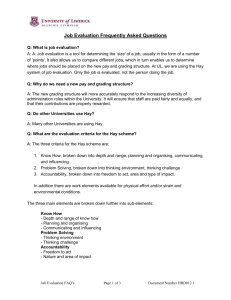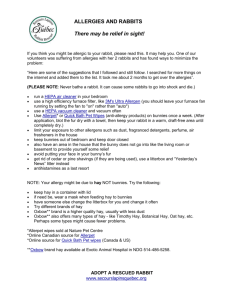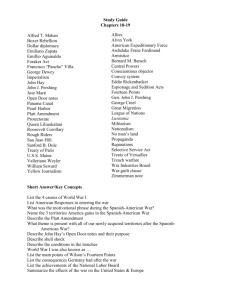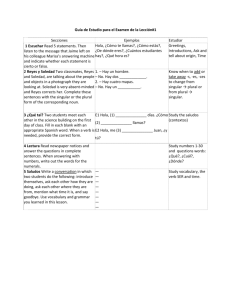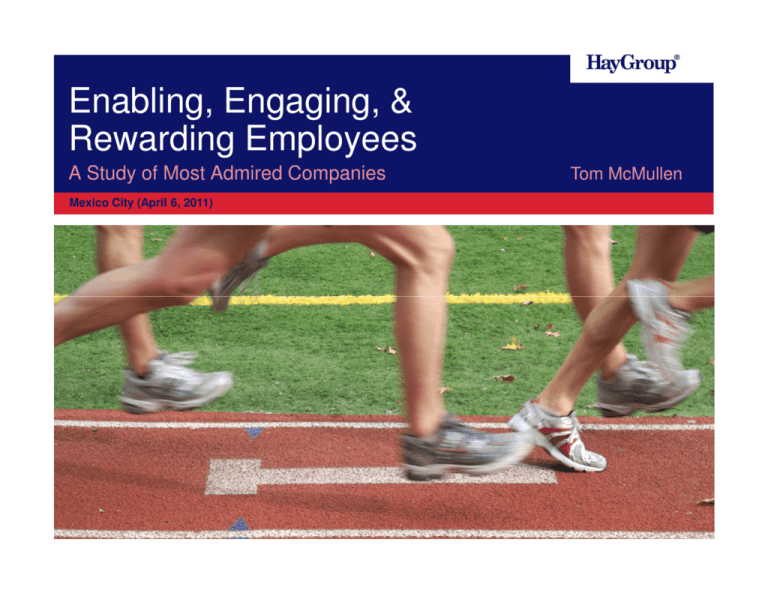
Enabling, Engaging, &
Rewarding Employees
A Study of Most Admired Companies
Mexico City (April 6, 2011)
Tom McMullen
Fortune survey of
World’s Most Admired Companies
What is it?
Fortune has combined the America's Most Admired Company (AMAC) survey
and the World's Most Admired Company (WMAC) survey to generate one
global ranking
Candidate companies: Fortune 1,000 companies; non-US Global 500
companies of $10 billion+ and top foreign companies operating in the US
Companies rated both overall and relative their industry peers by executives,
directors and analysts
A total of 667 companies from 33 countries were surveyed
Industry rankings generated for 55 industries
© 2010 Hay Group. All rights reserved
2
‘All stars’ for 2010
1
2
3
4
5
6
7
8
9
10
Apple
Google
Berkshire Hathaway
Johnson & Johnson
Amazon.com
Procter & Gamble
Toyota Motor
Goldman Sachs Group
Wal-Mart Stores
Coca-Cola
© 2010 Hay Group. All rights reserved
11
12
13
14
15
16
17
18
19
20
Microsoft
Southwest Airlines
FedEx
McDonald's
IBM
General Electric
3M
JP Morgan Chase
Walt Disney
Cisco Systems
3
The value of reputation
WMACs outperform industry peers and the market as a whole
Total shareholder returns
WMAC
S&P 500
One year
42.3%
26.5%
Three year
0.1%
(5.6)%
Five year
5.5%
0.4%
Ten year
4.0%
(0.9)%
© 2010 Hay Group. All rights reserved
4
This year’s research
Our focus
This year, our research focused on employee engagement issues
Explore organization approaches to retain and motivate employees in a tough
economic environment – and how they can reengage and reenergize their
workforces as they prepare for recovery-related growth
© 2010 Hay Group. All rights reserved
5
02
The business case for engaging
and enabling employees
Engaging and enabling employees
to drive performance
Work environments have to turn motivation into productivity
Employee effectiveness
Business results
Strategic intent
Engagement
Enablement
© 2010 Hay Group. All rights reserved
7
The business case for engaging and
enabling employees
Employee
performance
Increase in
employees above
performance
expectations
Employee
retention
Reduction in
turnover rates
Customer
satisfaction
Customer
satisfaction rates
Financial
success
Revenue growth
High
engagement
only
10%
-40%
71%
x2.5
High
engagement +
high enablement
50%
-54%
89%
x4.5
Based on linkage case studies using
Hay Group’s global normative database
© 2010 Hay Group. All rights reserved
8
03
Lessons Learned from WMACs
Lessons learned from WMACs
Key themes
Linking employee engagement to organizational objectives
Employee engagement in a downturn
Employee surveys and other approaches to measuring and monitoring
employee engagement
Ensuring line manager involvement in and attention to engagement initiatives
ROI on engagement efforts
Communicating employee engagement levels externally
© 2010 Hay Group. All rights reserved
10
Weaving employee engagement into
organizational fabric
Peer group
Most Admired
94
Our company has a specific
definition of employee engagement
81
88
HR staff across our company
have a good understanding of what
employee engagement is
79
88
Our company has developed
an explicit employer brand
67
0
20
40
60
80
100
% Favorable
© 2010 Hay Group. All rights reserved
11
WMACs were able to take less severe
actions amid the downturn
Peer group
Most Admired
WMACs made less extensive use of …
14
Hiring freezes
30
19
Compensation freezes
36
10
Layoffs
23
0
10
20
30
40
50
% Very great extent / great extent
© 2010 Hay Group. All rights reserved
12
WMACs are emerging from the recession
with more engaged and enabled people
Peer group
Most Admired
Rate now as compared with two years ago...
69
Employees’ loyalty
to the organization
49
73
Ease of recruiting talent
to fill key positions
57
Frustration among employees
over work conditions
not conducive to their success
44
31
0
20
40
60
80
100
% Greatly improved / improved
© 2010 Hay Group. All rights reserved
13
Ongoing measurement and monitoring
Peer group
Most Admired
How would you rate the
effectiveness of your employee
survey program in generating action
and change?
87
69
71
How successful has your company
been in linking employee
engagement to customer
satisfaction?
58
0
20
40
60
80
100
% Favorable
© 2010 Hay Group. All rights reserved
14
WMACs ensure line manager
involvement
Most Admired
Peer group
86
Line managers own
engagement initiatives
76
Engagement levels fostered by line
managers are a factor in performance
evaluations
75
77
65
Employee engagement metrics are
incorporated into variable pay programs
66
Employee engagement is
incorporated into leadership or
management development programs
90
82
0
20
40
60
80
100
% Favorable
© 2010 Hay Group. All rights reserved
15
WMACs are realizing a greater ROI on
engagement efforts
Peer group
Most Admired
I believe our efforts to
engage employee have:
Created a
competitive advantage
94
82
Reduced complaints
about pay fairness and equity
83
69
94
Reduced
turnover
67
85
Reduced employee
performance problems
72
84
Strengthened
customer relationships
72
0
20
40
60
80
100
% Strongly agree / agree
© 2010 Hay Group. All rights reserved
16
WMACs do more to communicate
engagement levels to outside stakeholders
Most Admired
How frequently do you share information
on employee engagement levels with...
Peer group
45
Investors
33
65
Prospective hires
56
51
Current/prospective customers
30
0
20
40
60
80
100
% Very frequently / frequently
© 2010 Hay Group. All rights reserved
17
04
Perspectives from Reward
Professionals
Research objectives
Survey of over 650 WorldatWork
members to:
− Identify reward practices
impacting employee engagement
− Identify what works and what can
be improved in the reward space
in engaging employees
− Identify reward and engagement
attributes and activities that
enhance organization
performance
© 2010 Hay Group. All rights reserved
19
Reward professionals believe:
Intangible rewards and leadership have more impact on
engagement than base pay, benefits, and incentives
Short term incentives are the tangible rewards that have the most
impact on engagement
Quality of work, work environment, career development, and senior
leadership are the intangible rewards that have the most impact
© 2010 Hay Group. All rights reserved
20
Impact of financial rewards on engagement
Base salary level
41%
Base salary increase
42%
Benefits and perquisites programs
44%
39%
48%
Short-term incentives or bonus
programs
32%
Financial recognition programs
32%
0%
20%
14%
30%
16%
44%
24%
50%
40%
% High
© 2010 Hay Group. All rights reserved
20%
37%
54%
Long-term incentives or bonus
programs
15%
60%
% Neither
18%
80%
100%
% Low
21
Impact of intangible rewards on engagement
The nature of the job or quality
of the work
69%
Work environment or
organizational climate
61%
Career development
opportunities
59%
28%
Non-financial recognition
programs
31%
37%
0%
20%
% High
60%
% Neither
10%
14%
16%
47%
40%
5%
11%
29%
55%
Work-life balance
© 2010 Hay Group. All rights reserved
26%
80%
100%
% Low
22
Impact of leadership on engagement
Manager’s assessment of
employee performance
65%
Coaching from managers or
supervisors
55%
Organizational objectives
53%
25%
36%
0%
20%
13%
37%
40%
% High
© 2010 Hay Group. All rights reserved
9%
34%
49%
Quality of senior leadership
60%
% Neither
9%
14%
80%
100%
% Low
23
Why people leave organizations
From our employee opinion research database (4MM
records), the factors that drive employees out of
organizations include (in rank order)
1. Career development opportunities
2. Compensation
3. Work climate
4. Manager/supervisory conflict
5. Lack of challenging work
6. Direction of organization
7. Lack of recognition
© 2010 Hay Group. All rights reserved
24
Impact of employee and manager
involvement in reward design on engagement
Conventional thinking and the research suggests that participation in
program design builds ownership and commitment.
And in this study we found reward program involvement is linked to
more positive views of effectiveness of reward strategies in engaging
employees (r ≥ .35)
However, we found very low levels of employee and manager
involvement in reward program design, implementation, and evaluation.
© 2010 Hay Group. All rights reserved
25
Employee involvement in reward programs
4%
16%
Design
40%
40%
4%
17%
Implementation
42%
37%
3%
18%
Evaluation
0%
39%
20%
40%
% Always
© 2010 Hay Group. All rights reserved
40%
60%
% Often
% Seldom
80%
100%
% Never
26
Manager involvement in reward
programs
8%
Design
Implementation
Evaluation
29%
12%
6%
0%
40%
31%
35%
27%
20%
22%
37%
40%
% Always
© 2010 Hay Group. All rights reserved
23%
39%
60%
% Often
% Seldom
80%
100%
% Never
27
Why is employee
and management
involvement so low?
05
Recommendations
Our top ten list
Organizational Priorities
Reward Priorities
1. Make a business case for
engaging employees
6. Go beyond comp & benefits to a
total rewards mindset
2. Measure and monitor
engagement
3. Take action on survey results
4. Make everyone responsible for
engagement
5. Connect people with the future
© 2010 Hay Group. All rights reserved
7. Include employees & managers
in reward design and launch
8. Tailor total rewards to workforce
segmentation
9. Use engagement metrics in
performance criteria
10.Communicate the value of what
you have
30
1. Make a business case for engaging employees
Employee engagement should not be confused with employee satisfaction.
Organizations that manage employee engagement most successfully clearly
articulate how high levels of employee motivation support core priorities (e.g.,
enhancing productivity and innovation, fostering and sustaining strong
customer relationships, and retaining top talent)
© 2010 Hay Group. All rights reserved
31
2. Measure and monitor engagement
Employee opinion surveys are important tools for
monitoring and managing employee engagement
Surveys are two-way communication tools
−
What is measured sends important signals to
employees about values and priorities.
−
Sharing results and a plan for action
demonstrates respect for employee input
© 2010 Hay Group. All rights reserved
32
3. Take action on survey results
The best companies make more frequent use of surveys than their peers
and they use the input more effectively
−
They indicate employee surveys are more effective in generating
action and change
−
They report doing more to link employee survey results to performance
outcomes, such as customer satisfaction
−
They say their best managers are more likely to take action
© 2010 Hay Group. All rights reserved
33
4. Make everyone responsible for
employee engagement
Engagement should be a priority for managers and employees at all levels
Senior Leaders
Human Resources
•
Share engagement index scores across functions
•
Align employer branding to key engagement drivers
•
Communicate expectations about engagement to
management team
•
Measure engagement levels and consult on key
actions
•
Model engaging leadership behaviors
•
•
Hold engagement conversations with top talent
Coach and support people managers in engaging
their teams
•
Incorporate engagement into performance
evaluations
People Managers
•
Understand and align with functional leaders’
expectations
•
Examine personal engagement
•
Build skill in management behaviors that impact
employee engagement
•
Hold engagement conversations with top talent
© 2010 Hay Group. All rights reserved
Employees
•
Discuss individual engagement factors with manager
•
Participate in the employee survey and other
feedback opportunities
•
Provide feedback to managers about the
effectiveness of engagement efforts
34
5. Connect people with the future
© 2010 Hay Group. All rights reserved
Maintaining high levels of
engagement requires
connecting people with jobs
and organizations and helping
them to see a positive future
for themselves and their
organizations.
Focus areas should include:
− Confidence in leadership
− Clear and promising
direction
− Development opportunities
35
6. Go beyond compensation and benefits
to a total reward mindset
Help leaders and managers understand that rewards
go far beyond compensation and benefits
Build the core organization messages (employment
value proposition) around what is meant by total
rewards
Develop tools for managers so they can effectively
reward employees beyond the confines of
compensation and benefits
Develop and reinforce communications
around total rewards
© 2010 Hay Group. All rights reserved
36
7. Include employees and managers in
reward design and launch
“We do employee surveys every
two years and make action plans
based upon the survey results.
One key finding is that we need to
do a better job at communicating
the total value of reward to our
employees.”
Guaranteed
cash
Intangible
reward
Annual
variable
term
Benefits Long
incentives
Heineken
“The real power is when you actually start
talking with your employees. We design our
reward programs, invest in new programs,
and beef up current programs based upon
the feedback we receive from our
employees.”
McDonalds
© 2010 Hay Group. All rights reserved
37
8. Tailor total rewards to workforce segmentation
Identify the most meaningful and valued ‘rewards’ in the organization:
Do reward values vary across the organization and work units?
Recognize that different employees value different rewards: What do
your boomers, generation X and Ys value?
Build the manager’s reward tool kit based on this understanding
− How can they use
− career development
− organization and job design
− non-financial recognition programs
− organizational work climate
… to reward employees?
© 2010 Hay Group. All rights reserved
38
9. Use engagement metrics in performance criteria
The Most Admired Companies have more balance performance scorecards
−
Balances timeframes, measurement level and measurement types
−
MACs using human capital measures are double their peer groups
Recognition that financial performance is driven by engagement
Establish baseline measures so
you can monitor trends
Human
Capital
© 2010 Hay Group. All rights reserved
Corporate
Financial
Short
Short term
term
Individual
Non-financial
Non-financial
Long
Long term
term
Customer
Social
Responsibility
Operational
39
10. Communicate the value of what you offer
‘Best’ practices and sophisticated designs fail if they are
not properly rolled out.
Clarify and focus on a few direct messages and tools
Use total reward statements
Help line managers understand and use
their tool kit to communicate reward value
© 2010 Hay Group. All rights reserved
40
What else is on your list?
© 2010 Hay Group. All rights reserved
41
Contact us
Tom McMullen
Hay Group (Chicago)
tom.mcmullen@haygroup.com
312.228.1848
© 2010 Hay Group. All rights reserved
42

